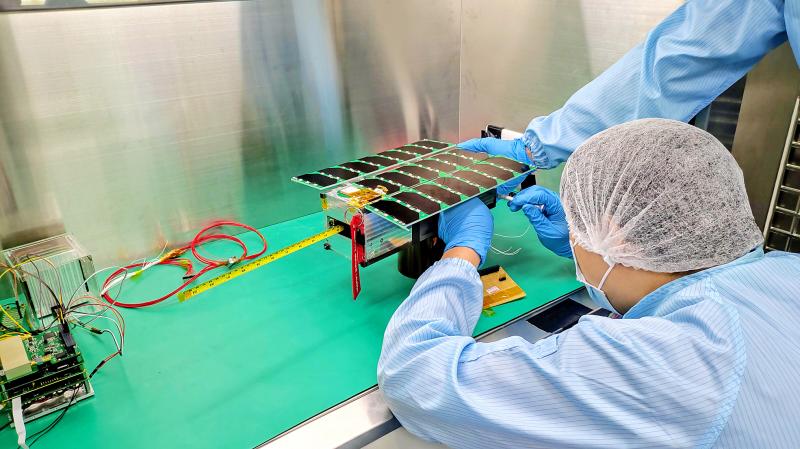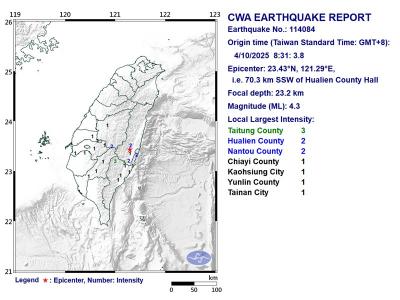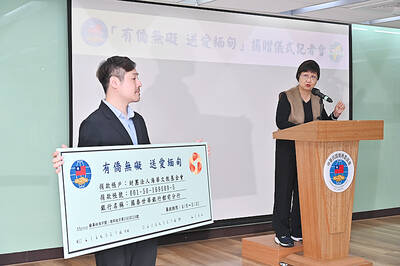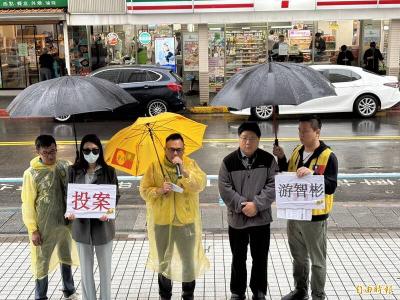The Czech Republic’s experience in making high-end instruments and assisting European Space Agency (ESA) missions makes Prague and Taipei complementary partners in the field of aerospace, especially as Taiwan aims to develop scientific instruments for a lunar orbiter, Taiwanese scientists say.
While the US and France have been the nation’s major foreign partners in space technology development over the past three decades, a Czech delegation’s visit to Taiwan last week might usher in new opportunities.
The National Space Organization (NSPO) plans to sign memorandums of understanding with the Czech Academy of Sciences’ (CAS) Institute of Atmospheric Physics, Charles University’s Faculty of Mathematics and Physics, and the Czech Technical University in Prague’s Institute of Experimental and Applied Physics.

Photo courtesy of National Central University Department of Space Science and Engineering
It is the first time that the NSPO plans to sign such agreements with Czech institutions, while individual Taiwanese and Czech scientists have sustained ties for years.
Taiwan’s world-leading research on ionospheric observations is appealing for Czech scientists, while their high-end engineering technology cultivated during the former Soviet Union is valuable for Taiwan, said Liu Jann-yenq (劉正彥), a professor at National Central University (NCU) department of space science and engineering.
His team has worked with the Institute of Atmospheric Physics under the CAS for nearly eight years, said Liu, who is also a member of the Central Europe Task Force at the Ministry of Science and Technology’s Center for Global Affairs and Science Engagement.
The team has developed a network of ionospheric observation stations using high-frequency Doppler sounders deployed in Hsinchu, Miaoli, Chiayi, Nantou, Yilan, Hualien and Taitung counties, he said.
The sounders transmit and receive radio signals to analyze ionospheric disruptions, which can influence radio communications and global positioning systems on Earth, he said.
Taiwan and the Czech Republic are also looking forward to more cooperation in the development of artificial satellites, he said.
The department in December plans to launch a cubesat for ionospheric observations, he added.
The Ionospheric Dynamics Explorer and Attitude Subsystem Satellite (IDEASSat) weighs nearly 4.5kg and has been completely developed, manufactured, and assembled by the department’s faculty and students, he said.
His team would share the data collected by IDEASSat with their Czech collaborators, as they can help download and analyze them, he said.
The cubesat would be launched by US company SpaceX on a rideshare launch brokered by ISILaunch in the Netherlands and HelioX Cosmos in Taiwan, a project funded by the NSPO, he added.
Other Taiwanese and Czech researchers are working on proposals to develop scientific payloads on a spacecraft that would orbit the moon, a mission announced by the NSPO.
The NSPO earlier this year made a call soliciting scientific payloads to be installed on a lunar orbiter as part of the nation’s third space technology development program, which began last year and would run through 2028.
The payloads can weigh up to 3kg and need to withstand drastic radiation and temperature changes during the cislunar cruise and in lunar orbit, and the flight models of the payloads would be delivered by the first quarter of 2024, according to an NSPO announcement last month.
The spacecraft, with a planned dry mass of 150kg, would be sent to an orbit 100km above the moon, the announcement said, without naming the maker of the spacecraft.
Asked about the NSPO’s call, department director Chao Chi-kuang (趙吉光) said the department plans to develop an instrument to measure electromagnetic parameters on the lunar surface to deepen scientists’ understanding of the moon’s mantle.
Chao’s team has developed an Advanced Ionospheric Probe that was installed on Taiwan’s own Formosat-5 satellite, which was launched on a SpaceX Falcon 9 in 2017.
The department also aims to work with Charles University to develop an instrument to measure solar particles, he said.
Chao said he initially had reservations about the NSPO’s call, given Taiwan’s lack of experience in making instruments that can resist higher cosmic radiation outside the Earth’s magnetic field.
Nonetheless, he became more interested in it after building ties with Charles University, Chao said.
While the Czech Republic does not have a national agency similar to the NSPO, its Czech Space Alliance — an association of aerospace firms — is part of the ESA supply chain and has more experience in making instruments to explore other planets, he said.
Deepening ties with Czech institutions and the country’s space industry would allow Taiwan to save time on lunar exploration, as it attempts to move from Earth-centered observations to missions targeting other planets, Chao said.
The moon’s rich reserves of helium-3, a potential nuclear fuel, are worth investigating, and the moon can be regarded as a logistics station for missions to Mars, he added.
Gilbert Pi (畢可為), an NCU graduate working at Charles University’s Faculty of Mathematics and Physics, helped connect NCU and the NSPO to the faculty.
Pi said he had visited Prague several times while studying under his NCU adviser Shue Jih-hong (許志浤), who maintains close ties with the Czech faculty.
Having become a project researcher there after three years of postdoctoral research, Pi said he enjoys being part of the Space Physics Group led by professor Zdenek Nemecek, adding that he is the only non-European member of the team.
Their group has developed instruments for missions led by the ESA and Russia, and is glad to share its experience with Taiwan, he said.
Taiwan’s third space program also attracts many Czech institutions, he added.
In addition to the moon exploration project, Taiwan’s third space program also involves the development of six high-resolution optical remote sensing satellites, two super-high-resolution remote sensing satellites and two synthetic aperture radar satellites.
Professor Loren Chang (張起維) said he represented the department last week in a meeting with the members of the Czech Space Alliance at a trade forum during their visit to Taiwan with Czech Senate President Milos Vystrcil.
Some Czech companies specializing in satellite navigation systems or infrared sensors have expressed an interest in the department’s satellite development as well as research on the impact of ionospheric disruptions on communications, Chang said.
Asked about the lunar exploration project, Deputy Minister of Science and Technology Shieh Dar-bin (謝達斌) said a major hurdle is the loss of satellite or spacecraft communications on the far side of the moon, so advancing communications, materials, engine combustion and autocontrol technologies would be necessary to develop a lunar orbiter.
The ministry could help gather experts for the NSPO’s lunar exploration project, while foreign resources, such as a planned SpaceX lunar lander, would be part of its considerations as well, he said.

Taiwan is stepping up plans to create self-sufficient supply chains for combat drones and increase foreign orders from the US to counter China’s numerical superiority, a defense official said on Saturday. Commenting on condition of anonymity, the official said the nation’s armed forces are in agreement with US Admiral Samuel Paparo’s assessment that Taiwan’s military must be prepared to turn the nation’s waters into a “hellscape” for the Chinese People’s Liberation Army (PLA). Paparo, the commander of the US Indo-Pacific Command, reiterated the concept during a Congressional hearing in Washington on Wednesday. He first coined the term in a security conference last

A magnitude 4.3 earthquake struck eastern Taiwan's Hualien County at 8:31am today, according to the Central Weather Administration (CWA). The epicenter of the temblor was located in Hualien County, about 70.3 kilometers south southwest of Hualien County Hall, at a depth of 23.2km, according to the administration. There were no immediate reports of damage resulting from the quake. The earthquake's intensity, which gauges the actual effect of a temblor, was highest in Taitung County, where it measured 3 on Taiwan's 7-tier intensity scale. The quake also measured an intensity of 2 in Hualien and Nantou counties, the CWA said.

The Overseas Community Affairs Council (OCAC) yesterday announced a fundraising campaign to support survivors of the magnitude 7.7 earthquake that struck Myanmar on March 28, with two prayer events scheduled in Taipei and Taichung later this week. “While initial rescue operations have concluded [in Myanmar], many survivors are now facing increasingly difficult living conditions,” OCAC Minister Hsu Chia-ching (徐佳青) told a news conference in Taipei. The fundraising campaign, which runs through May 31, is focused on supporting the reconstruction of damaged overseas compatriot schools, assisting students from Myanmar in Taiwan, and providing essential items, such as drinking water, food and medical supplies,

New Party Deputy Secretary-General You Chih-pin (游智彬) this morning went to the National Immigration Agency (NIA) to “turn himself in” after being notified that he had failed to provide proof of having renounced his Chinese household registration. He was one of more than 10,000 naturalized Taiwanese citizens from China who were informed by the NIA that their Taiwanese citizenship might be revoked if they fail to provide the proof in three months, people familiar with the matter said. You said he has proof that he had renounced his Chinese household registration and demanded the NIA provide proof that he still had Chinese